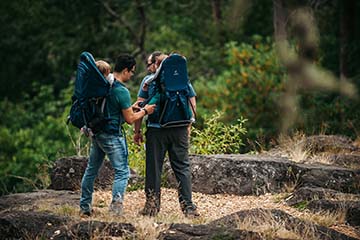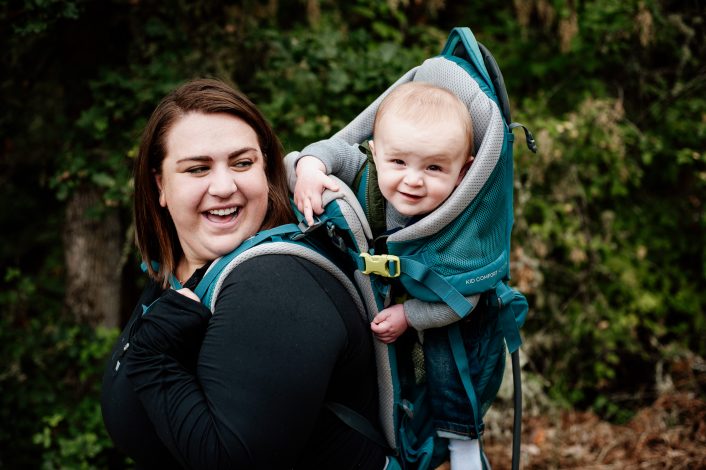How to Adjust a Child Carrier for all Body Types
[embed]https://youtu.be/_zMbo_Ibfv4[/embed]

 For petite and tall moms, is important to remember that your height alone does not determine your best fit. Another important factor is your chest size. The sternum strap’s purpose is to keep the shoulder straps in place and can slide up or down to create a custom fit for different sizes. It’s best to adjust the sternum strap last, after the shoulder straps are on, tightened, and comfortable.
And now it’s time to hit the trail and enjoy your hike with your most comfortable carrier fit.
The best way to hit the trail in comfort is with a community of like-minded parents who are raising a generation to love the outdoors. Start your free Hike it Baby membership trial today!
For petite and tall moms, is important to remember that your height alone does not determine your best fit. Another important factor is your chest size. The sternum strap’s purpose is to keep the shoulder straps in place and can slide up or down to create a custom fit for different sizes. It’s best to adjust the sternum strap last, after the shoulder straps are on, tightened, and comfortable.
And now it’s time to hit the trail and enjoy your hike with your most comfortable carrier fit.
The best way to hit the trail in comfort is with a community of like-minded parents who are raising a generation to love the outdoors. Start your free Hike it Baby membership trial today!
Finding Your Child Carrier Fit
Have you ever put on a child carrier and felt the straps digging into your shoulder or hips? Are you unsure of how to correctly adjust a child carrier to fit just right? Well, you’ve come to the right place. To help ensure you and your little one have a comfortable hike, we bring you a few easy tips on how to adjust your child carrier to fit your body type.Getting Started
Always start by making adjustments for your baby in the cockpit. Get more information on fitting a child carrier in this video. After that, the first consideration is to make sure it fits your torso length. Your torso length is the distance from the base of your neck to the base of your spine, which is on the same line as the top of your hip bone. Without proper adjustment, it could allow for a gap in the shoulder straps, and bounce while you walk. This will hurt your shoulders over time. On the opposite side, when it’s too short, it will dig into your shoulders and become painful quickly.
Shoulder Strap Adjustment
The shoulder straps should be snug, but loose enough to slide a finger underneath. Load adjusters should be tightened until there is no slack to help keep the carrier closer to your body. They are likely to be at about a 45-degree angle. Start in a neutral position to find a perfect fit every time.Hip Belt Adjustment
Make sure the belt sits on your hips, and not on your waist, for an optimal distribution of your combined weight. A good tip for ensuring the hip belt is in the right place is checking to see if the buckle is aligned with your belly button. Always remember to lift with your legs and not your back when you put the carrier on.Hiker Height
 For petite and tall moms, is important to remember that your height alone does not determine your best fit. Another important factor is your chest size. The sternum strap’s purpose is to keep the shoulder straps in place and can slide up or down to create a custom fit for different sizes. It’s best to adjust the sternum strap last, after the shoulder straps are on, tightened, and comfortable.
And now it’s time to hit the trail and enjoy your hike with your most comfortable carrier fit.
The best way to hit the trail in comfort is with a community of like-minded parents who are raising a generation to love the outdoors. Start your free Hike it Baby membership trial today!
For petite and tall moms, is important to remember that your height alone does not determine your best fit. Another important factor is your chest size. The sternum strap’s purpose is to keep the shoulder straps in place and can slide up or down to create a custom fit for different sizes. It’s best to adjust the sternum strap last, after the shoulder straps are on, tightened, and comfortable.
And now it’s time to hit the trail and enjoy your hike with your most comfortable carrier fit.
The best way to hit the trail in comfort is with a community of like-minded parents who are raising a generation to love the outdoors. Start your free Hike it Baby membership trial today!
About Hike it Baby
Hike it Baby is a 501(c)(3) non-profit organization dedicated to getting families outdoors and on trails across the U.S. and internationally, supporting, educating and inspiring families through their more than 300 communities across North America. Since its grassroots inception in 2013 in Portland, Oregon, Hike it Baby is now a growing community of 270,000 families and 500 volunteer branch ambassadors hosting more than 1,600 hikes per month. More information, as well as daily hike schedules, can be found at HikeitBaby.com, Facebook, YouTube, Pinterest, and Instagram. This post is sponsored by Deuter, however, we would never recommend a product we do not love. Photos courtesy of Michelle Craig.Related Content




Comments